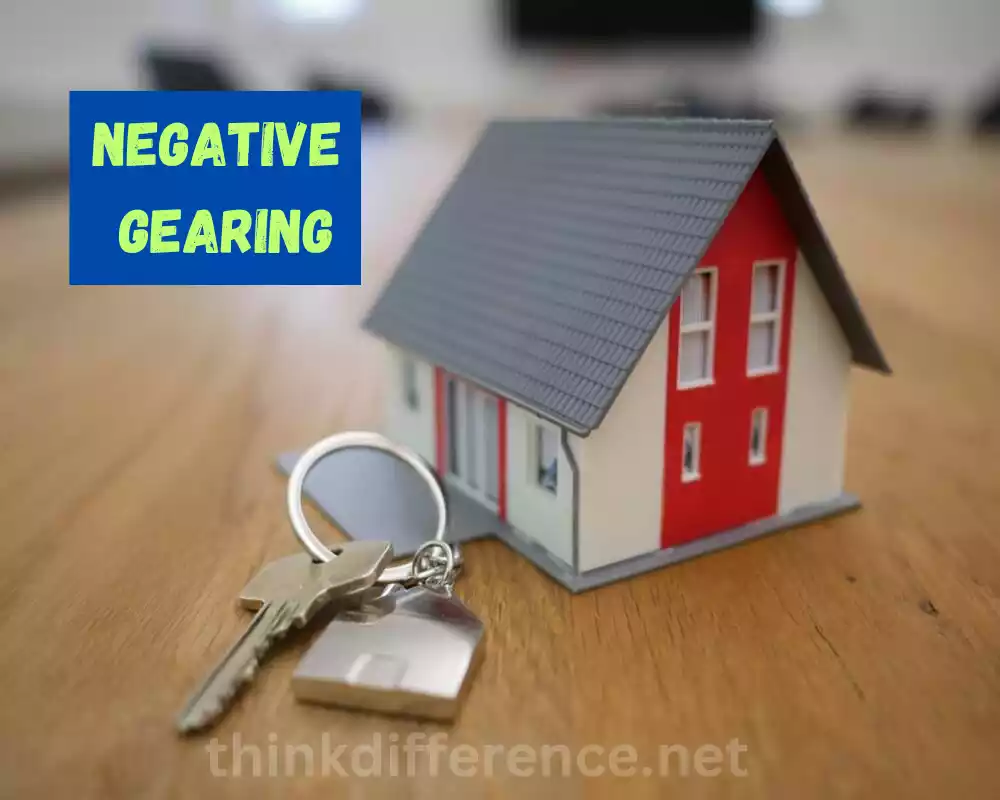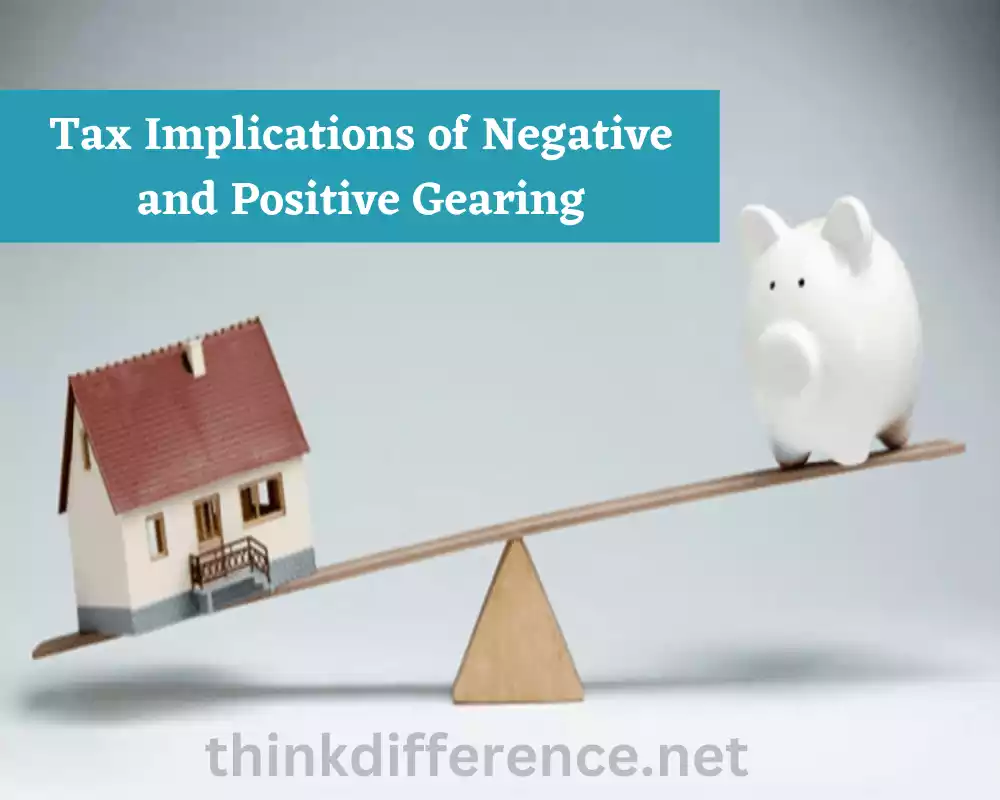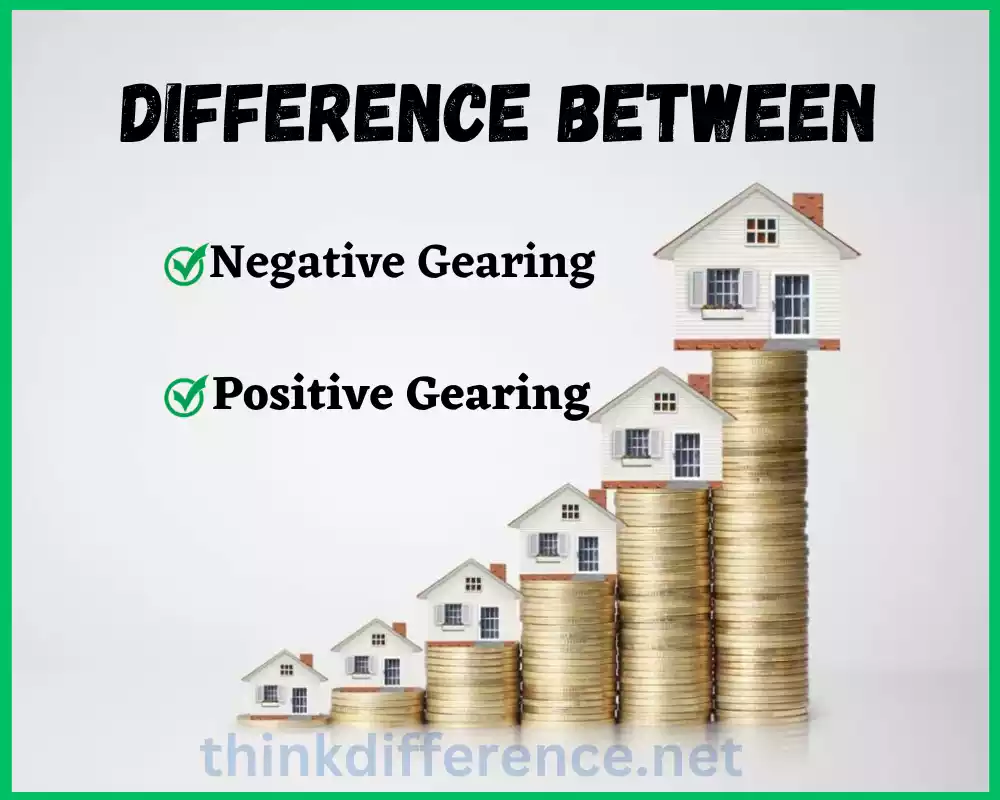Negative and Positive Gearing are two distinct financial strategies used by investors to maximize income while managing tax liabilities. We will examine both positively and negatively gearing, detailing its advantages and disadvantages as well as any consequences of investment decisions utilizing them. At the end of our discussion we hope you have gained enough understanding to make more informed choices when investing.
What is Negative Gearing?
Negative gearing refers to an investment strategy where an investor borrows to acquire real estate or shares at below market values in hopes that its revenue generates lower revenues than expenses associated with owning them, leading to losses on financial accounts as costs exceed income generated from them.

Negative gearing refers to real property transactions when its rental income does not cover interest for its loan and expenses such as maintenance, insurance and council fees owed. Its owner has to cover this deficit from their own pocket which leads to decreased cash flow.
Negative gearing’s primary aim is to take full advantage of tax benefits associated with investments which are losing money. Australia, Canada and certain European nations allow investors to deduct losses from negatively geared investments from their taxable income; this decreases your overall tax obligation significantly and could potentially lower it substantially.
Negative gearing offers tax benefits but also involves risk. Investors must remain mindful of their ability to meet ongoing expenses associated with an investment property when interest or rate changes impede funding, particularly during periods with lower than usual yields or rate rises. Negative gearing works on the assumption that its worth will appreciate over time so investors may realize capital gains income should they choose to sell at some point in the future.
Negative gearing is an investment strategy used by investors to reduce tax payments while investing in long-term profits and profitability.
Advantages of Negative Gearing
Negative gearing offers several advantages for investors. Some of the key advantages of negative gearing include:
- Tax benefits: Negative gearing offers numerous potential tax benefits that make the practice attractive, such as increased deductions. In many countries, investors can deduct the losses incurred from negatively geared investments against their taxable income. This deduction reduces their overall tax liability, potentially resulting in a lower tax bill. This can be particularly advantageous for high-income earners.
- Potential for capital growth: Negative gearing is often utilized when investing in real estate, as investors expect the value of their property to increase over time. Although short-term cash flows might be negative, investors typically anticipate potential capital gains should they decide to sell in the near future. If the property’s value increases significantly, investors can realize a substantial profit.
- Asset accumulation: Negative gearing allows investors to acquire assets, such as properties or shares, without having to finance the entire purchase themselves. By leveraging borrowed funds, investors can expand their portfolio and accumulate assets that may appreciate in value over time. This can contribute to long-term wealth creation.
- Diversification opportunities: Negative gearing can provide investors with opportunities to diversify their investment portfolio. By investing in various assets – like real estate properties from various locations or shares from different industries – investors can diversify and reduce risk, creating an investment portfolio with greater balance and stability.
- Potential rental income growth: While negatively geared properties may not generate sufficient rental income to cover all expenses, there is a possibility of rental income growth over time. As property demand increases or rental rates rise, investors may experience higher rental yields, which can contribute to a positive cash flow in the future.
Be mindful that the benefits of negative gearing depend on factors like an investor’s finances, market conditions and tax laws in his or her specific location or country. Before engaging in negative gearing, it is advisable to seek professional financial advice to evaluate its suitability and potential benefits in individual circumstances.
Disadvantages of Negative Gearing
While negative gearing offers potential advantages, it also comes with several disadvantages and risks. Before choosing negative gearing as a strategy for investing, investors must carefully consider all possible aspects. Some of the key disadvantages of negative gearing include:
- Negative cash flow: The most apparent drawback of negative gearing is the negative cash flow it creates. Since the expenses associated with the investment exceed the income generated, investors need to cover the shortfall from their own pocket. This can place significant strain on an investor’s cash flow, particularly if they have multiple negatively geared properties or face unexpected financial challenges.
- Dependency on capital growth: Negative gearing relies on the assumption that the value of the investment will appreciate over time. If the anticipated capital growth does not materialize as projected, investors might not be able to recover losses and achieve expected returns from investment. The unpredictable nature of the property market makes capital growth uncertain, and investors should be prepared for fluctuations in property values.
- Limited rental income: Negatively geared properties often generate rental income that is insufficient to cover the expenses associated with the investment. This means investors are reliant on future rental increases to potentially achieve positive cash flow. Rent rates remain unpredictable in today’s rental market and without assurances of substantial rent increases, further aggravating cash flow issues.
- Interest rate and market risk: Negative gearing exposes investors to interest rate risk. As interest rates increase, loan repayment costs also escalate and create gaps in cashflow. Negative gearing also exposes investors to market risk as rental properties’ values and demand may fluctuate depending on multiple circumstances – economic factors, shifts in demographics or shifts in the local property market are just a few examples of factors which might alter them.
- Limited tax benefits in some jurisdictions: While negative gearing provides tax advantages in many countries, it’s worth noting that tax laws can change over time. Governments may alter tax policies and limit or remove the deductions associated with negative gearing, reducing its tax benefits for investors. Therefore, it’s crucial to stay informed about potential legislative changes that could impact the tax advantages of negative gearing.
- Cash flow strain during vacancies: Vacancies in rental properties can have a significant impact on negatively geared investments. If a property remains vacant for an extended period, the investor is solely responsible for covering all expenses without any rental income to offset the costs. This can create additional financial strain and impact the investor’s ability to sustain the investment.
Investors considering negative gearing should carefully assess their financial situation, risk tolerance, and the specific market conditions before making any investment decisions. Seeking professional advice from financial and tax experts can help in evaluating the suitability and potential risks associated with negative gearing.
What is Positive Gearing?
Positive Gearing (PG) is an investment strategy wherein revenue generated from an asset exceeds its cost to own or maintain it, creating positive cash flow from this particular investment. Simply stated, an investment produces positive cash flow when its income generated exceeds expenses incurred to acquire or own it.

Positive gearing refers to real estate investment when the income generated from rental properties exceeds their expenses, such as mortgage payments and property management costs, maintenance, insurance premiums and any related charges. After taking into account all associated expenses, any surplus is seen as an increase in cash flow for investors.
Positive gearing offers investors with many distinct advantages, with its main one being providing them with a steady cash flow surplus from their investments to use towards paying property costs, speedier loan repayment or passively investing it elsewhere – providing investors with an income source from investments they already hold.
Advantages of Positive Gearing
Positive gearing offers several advantages for investors. Some of the key advantages of positive gearing include:
- Regular income stream: Positive gearing generates a consistent income stream for investors. The surplus rental income received each period contributes to the investor’s cash flow, providing a steady source of income that can be utilized for personal expenses or reinvested in other ventures. This regular income can provide financial stability and reduce reliance on other income sources.
- Potential for higher returns: Positive gearing is designed to generate a profit from the outset. The surplus income received from the investment property contributes to higher overall returns. This can be especially beneficial for investors seeking immediate returns and income stability. The surplus cash flow can be reinvested in additional assets, further increasing the potential for wealth accumulation and compounding returns.
- Reduced financial strain: Positive gearing reduces the financial strain associated with covering ongoing expenses. Since the rental income exceeds the costs, investors are not required to rely on their personal funds to cover the property expenses. This can provide a greater sense of financial security and stability, as investors have a surplus to cover unexpected expenses or other financial commitments.
- Reduced dependency on capital growth: Unlike negative gearing, positive gearing is less reliant on the expectation of capital growth. While capital growth can still contribute to the overall return on investment, positive gearing focuses primarily on generating income from the property’s rental yield. This makes it less dependent on market fluctuations and provides investors with a more stable and predictable income source.
- Diversification opportunities: Positive gearing can provide investors with opportunities to diversify their investment portfolio. By generating a regular income stream, investors can allocate surplus funds to invest in other assets or ventures. This allows for diversification across different asset classes and potentially reduces risk by spreading investments across multiple income-generating assets.
- Potential for mortgage repayment acceleration: With positive gearing, the surplus cash flow generated from the investment property can be used to accelerate mortgage repayments. By making additional repayments, investors can reduce the principal loan amount and shorten the loan term. This can result in interest savings and increased equity in the property at a faster rate.
- Tax considerations: Depending on the tax laws of a particular jurisdiction, positively geared investments may still offer some tax benefits. While the surplus income generated is typically taxable, investors may be able to offset some expenses and claim deductions, reducing their overall tax liability. It’s important to consult with tax professionals to understand the specific tax implications and benefits in a given jurisdiction.
Positive gearing can be a suitable strategy for investors seeking regular income, stability, and the potential for higher returns. It’s important to carefully evaluate individual circumstances, market conditions and the specific property investment to ensure its suitability and potential advantages. Consulting with financial advisors or property professionals can provide valuable insights and guidance when considering positive gearing as an investment strategy.
Disadvantages of Positive Gearing
While positive gearing offers potential advantages, it also comes with several disadvantages and risks. It’s important for investors to consider these factors before engaging in positive gearing.
Some of the key disadvantages of positive gearing include:
- Limited tax benefits: In some jurisdictions, the tax benefits associated with positive gearing may be limited compared to negative gearing. Since the investment generates a surplus income, the taxable portion of the income may reduce the overall tax benefits available to the investor. It’s crucial to understand the specific tax laws and regulations in the relevant jurisdiction to accurately assess the tax implications of positive gearing.
- Lower potential for capital growth: Positive gearing primarily focuses on generating income from the property’s rental yield, rather than relying on capital growth. While this can provide a stable income stream, it may result in lower potential for substantial capital appreciation compared to investments that heavily rely on capital growth. Investors seeking significant capital gains may need to consider alternative investment strategies.
- Market and rental risks: Positive gearing does not guarantee rental income stability or future rental increases. Market conditions and rental demand can fluctuate, impacting the rental yield and potential income generated. If there is a decline in rental rates or increased vacancies, the surplus income from positive gearing may decrease or even turn into a negative cash flow. It’s important to assess the rental market conditions and conduct thorough research before investing in a positively geared property.
- Limited cash flow for personal use: While positive gearing generates a surplus income, investors may choose to reinvest the surplus back into the property or other investments to maximize returns. This can limit the availability of cash flow for personal use or other financial goals. Investors should carefully consider their financial needs and objectives to ensure that positive gearing aligns with their overall financial plan.
- Property management challenges: Owning a positively geared property comes with responsibilities such as property management, tenant selection, maintenance, and administration. Investors need to allocate time and resources for managing the property or consider engaging a property management service, which incurs additional costs. Failure to manage the property effectively can result in increased expenses or rental income disruptions.
- Potential for overpaying for the property: In some cases, investors may be enticed by the high rental yield of a property and overlook other important factors such as property quality, location and potential for capital growth. This can lead to overpaying for the property and potentially limit future returns. It’s crucial to conduct thorough due diligence and evaluate the investment property holistically, considering both the rental income and long-term growth potential.
It’s important to carefully assess individual financial goals, risk tolerance and market conditions before engaging in positive gearing. Consider consulting with financial advisors or property professionals to gain a comprehensive understanding of the potential risks and disadvantages associated with positive gearing in a specific context.
Comparison of Negative and Positive Gearing
Negative Gearing:
- Cash Flow: Negative gearing generates a negative cash flow, where the expenses exceed the income generated from the investment.
- Tax Benefits: Investors can deduct the losses incurred from negatively geared investments against their taxable income, reducing their overall tax liability.
- Reliance on Capital Growth: Negative gearing relies on the expectation of future capital growth to potentially offset the losses incurred in the short term.
- Potential Risks: Negative gearing carries risks such as cash flow strain, interest rate and market risk and dependency on property value appreciation.
- Short-Term Tax Advantage: Investors can benefit from immediate tax deductions, reducing their tax payable in the short term.
- Potential for Capital Gains: Negative gearing aims to realize capital gains when the property is sold, relying on the property’s value appreciation over time.
Positive Gearing:
- Cash Flow: Positive gearing generates a positive cash flow, where the income exceeds the expenses associated with the investment.
- Regular Income Stream: Investors receive a consistent income stream from the surplus rental income, providing financial stability.
- Reduced Reliance on Capital Growth: Positive gearing focuses on generating income from rental yields rather than relying heavily on capital growth.
- Potential Risks: Positive gearing may still face risks such as market fluctuations, rental demand changes and limited tax benefits.
- Long-Term Income Generation: Positive gearing provides a reliable source of income for investors, which can be used for personal expenses or reinvested for wealth accumulation.
- Potential for Mortgage Repayment Acceleration: The surplus income from positive gearing can be used to accelerate mortgage repayments, reducing the loan term and increasing equity in the property.
The key difference between negative and positive gearing lies in their cash flow outcomes and tax implications. Negative gearing results in negative cash flows with potential tax benefits; positive gearing on the other hand generates positive cash flow but may only offer limited tax savings.
When choosing between negative gearing or positive gearing as an approach to investing, an individual’s financial objectives, risk tolerance, market conditions and any associated risks should all be carefully taken into consideration before reaching a definitive decision based on facts alone.
Strategies for Successful Negative Gearing
To pursue successful negative gearing, investors can consider implementing the following strategies:
- Thorough Research and Due Diligence: Conduct extensive research on the property market, including location, rental demand, growth potential and vacancy rates. Thoroughly analyze comparable property prices, rental yields and historical data to identify properties with strong potential for capital growth.
- Seek Professional Advice: Consult with professionals such as real estate agents, property managers and financial advisors who have experience in negative gearing. They can provide valuable insights, market knowledge and advice on investment opportunities, cash flow projections and potential risks.
- Property Selection: Choose properties that have the potential to generate strong rental income. Look for properties in high-demand areas with desirable amenities, proximity to transport, schools and employment hubs. Consider the preferences and needs of potential tenants to attract a consistent stream of rental income.
- Cash Flow Management: Develop a comprehensive budget and cash flow management plan to ensure there are sufficient funds to cover the negative cash flow. Account for expenses such as loan repayments, property management fees, insurance, maintenance and potential vacancies. Set aside a contingency fund for unexpected costs.
- Loan Structure and Interest Rates: Optimize the loan structure by considering options such as interest-only loans or using an offset account to reduce interest costs. Keep a close eye on interest rates and consider fixing the loan rate if favorable conditions exist. Regularly review loan terms to ensure competitiveness in the market.
- Rental Income Optimization: Continuously review rental rates and adjust them to market conditions. Engage a professional property manager to ensure optimal rental income and tenant retention. Enhance the property’s appeal through renovations or upgrades to attract higher-quality tenants and potentially command higher rental rates.
- Tax Planning: Work closely with a tax professional to maximize the available tax benefits associated with negative gearing. Understand the applicable tax laws and deductions, such as interest expense deductions, depreciation allowances and other property-related expenses that can be claimed.
- Long-Term Strategy: Consider negative gearing as part of a long-term investment strategy. Look beyond the short-term negative cash flow and focus on the potential for capital growth over time. Regularly review the investment performance, reassess market conditions and adjust the strategy accordingly.
- Portfolio Diversification: Diversify the investment portfolio to mitigate risk. Consider spreading investments across different property types, locations and asset classes. This can help balance the overall risk profile and potentially offset any underperforming negatively geared properties.
- Regular Monitoring and Review: Regularly monitor the investment performance, rental market conditions and financial situation. Conduct periodic reviews of the property’s performance, cash flow projections and potential refinancing opportunities. Stay informed about changes in tax laws and regulations that may impact negative gearing strategies.
Remember, negative gearing involves risks and success depends on various factors, including market conditions, property selection and individual circumstances. Seeking professional advice and staying well-informed are crucial for implementing successful negative gearing strategies.
Strategies for Successful Positive Gearing
To pursue successful positive gearing, investors can consider implementing the following strategies:
- Thorough Market Research: Conduct comprehensive research on the property market, focusing on areas with strong rental demand and potential for rental yield. Analyze historical rental data, vacancy rates and market trends to identify properties with the potential for positive cash flow.
- Property Selection: Choose properties that are likely to generate high rental income relative to the purchase price and expenses. Find homes for rent in areas with low vacancies, high population growth and convenient services nearby that also boast strong rental demand. Consider factors that appeal to potential tenants, such as location, size and features.
- Cash Flow Analysis: Conduct a detailed cash flow analysis to accurately assess the potential income and expenses of the investment property. Factor in mortgage repayments, property management fees, insurance, maintenance costs and other expenses. Ensure that the projected rental income exceeds the total expenses to achieve positive cash flow.
- Effective Property Management: Engage a professional property manager to efficiently handle tenant selection, rental collection, property maintenance and lease management. A competent property manager can help maximize rental income, minimize vacancies and ensure a smooth operation of the investment property.
- Regular Rental Reviews: Conduct regular rental reviews to ensure that the property is achieving optimal rental income. Stay informed about rental market conditions, local rental trends and competition to adjust rental rates accordingly. Aim to strike a balance between maximizing rental income and maintaining tenant satisfaction and retention.
- Cost Management: Seek opportunities to minimize expenses without compromising the property’s quality or attractiveness to tenants. Compare insurance policies, property management fees and other service providers to ensure competitive pricing. Regularly review and negotiate contracts to secure favorable rates.
- Mortgage Considerations: Explore various mortgage options to optimize financing. Consider factors such as interest rates, loan terms, repayment structures and potential tax benefits. Engage with mortgage brokers or financial advisors to identify the most suitable financing strategy for positive gearing.
- Property Maintenance and Upgrades: Maintain the property in good condition to attract quality tenants and potentially command higher rental income. Address maintenance issues promptly, conduct regular inspections and consider cost-effective upgrades or renovations that can increase rental value and desirability.
- Tax Planning: Work closely with a tax professional to understand and maximize the available tax benefits associated with positive gearing. Identify eligible deductions, such as property expenses, depreciation allowances and interest payments, to reduce tax liability and optimize the investment’s financial performance.
- Portfolio Diversification: Consider diversifying the investment portfolio to spread risk and potentially increase returns. Explore opportunities to invest in different property types, locations or asset classes to create a well-balanced and diversified portfolio.
- Regular Performance Evaluation: Continuously monitor and evaluate the investment performance. Review cash flow, rental income, expenses and market conditions on a regular basis. Regularly assess the property’s performance against set benchmarks and adjust the strategy as needed.
Remember that positive gearing comes with its own risks, including potential changes in rental demand, market fluctuations, and ongoing property management responsibilities. It is essential to thoroughly research, plan and seek professional advice when implementing positive gearing strategies to maximize success.
Tax Implications of Negative and Positive Gearing
The tax implications of negative gearing and positive gearing differ significantly. Here’s an overview of the tax implications associated with each strategy:

Negative Gearing:
- Tax Deductions: With negative gearing, investors can claim tax deductions for the expenses incurred in generating rental income. This includes deductions for interest on loans, property management fees, insurance, repairs and maintenance, council rates, and depreciation of assets within the property.
- Offset against Other Income: The losses incurred from negatively geared investments can be offset against an investor’s other income, such as salary or business income. This can result in a reduction of the investor’s taxable income and potentially lower their tax liability.
- Capital Gains Tax (CGT): When the negatively geared property is eventually sold, any capital gains made will be subject to CGT. Capital gains tax is calculated based on the increase in property’s value from when purchased to its eventual sale, plus any discounts or exemptions granted based on holding period.
- Tax Advantages for High-Income Earners: Negative gearing tends to benefit those with higher incomes most, as higher marginal tax rates allow greater deductions from taxes. The losses incurred from the investment property can help reduce the tax payable on their other income at a higher rate.
Positive Gearing:
- Taxable Rental Income: With positive gearing, the rental income generated from the investment property is taxable. Once expenses have been subtracted from excess income, any remaining proceeds are added to an investor’s assessable income and taxed at their marginal tax rate.
- Tax on Rental Income: The rental income earned from positively geared investments is subject to tax at the investor’s applicable marginal tax rate. An investor is responsible for reporting rent earned and paying taxes accordingly.
- Limited Deductions: Unlike negative gearing, where expenses can result in tax deductions, there are fewer deductions available for positively geared properties. Some expenses related to managing and maintaining the home could still qualify as tax deductions.
- Potential for Tax Liability: Since positively geared investments generate taxable income, investors may have a higher tax liability compared to negatively geared investments. It’s important for investors to factor in the tax payable on the rental income when assessing the overall financial viability of positive gearing.
Keep in mind that tax law and rules vary between jurisdictions. Investors are advised to speak to accountants or tax experts familiar with their country or region’s unique rules in order to fully comprehend any possible positive or negative tax repercussions from gearing strategies for positive or negative returns for their individual situation.
The above info provides only an outline. For an in-depth examination, investors are recommended speaking with professionals familiar with local taxes who specialize in investment law as an advisor should.
Risks and Considerations
When considering negative or positive gearing as an investment strategy, it is crucial that you are aware of all associated risks and ramifications. Here are a few key points for your consideration:

Risks and Considerations of Negative Gearing:
- Cash Flow Strain: Negative gearing can put a strain on cash flow, especially if rental income doesn’t cover the expenses. Investors need to ensure they have sufficient funds to cover the negative cash flow and any unexpected expenses.
- Interest Rate Risk: Changes in interest rates can impact the cost of borrowing for the investment property. If interest rates rise significantly, it can increase the expenses and worsen the negative cash flow.
- Market Fluctuations: Property values and rental demand can be subject to market fluctuations. A decline in property prices or a downturn in the rental market can impact the expected returns and profitability of negatively geared investments.
- Rental Vacancies: Extended periods of rental vacancies can further exacerbate the negative cash flow, as there is no rental income to offset the expenses. It’s important to consider factors that affect rental demand, such as location and economic conditions.
- Capital Growth Uncertainty: Negative gearing relies on the expectation of future capital growth to offset the losses. There is no guarantee that property values will increase significantly over time, which can impact the overall investment returns.
- Tax Law Changes: Tax laws and regulations related to negative gearing can change over time. Investors should stay informed about any potential changes that could affect the tax benefits associated with negatively geared investments.
Risks and Considerations of Positive Gearing:
- Limited Tax Benefits: Unlike negative gearing, positive gearing may offer limited tax benefits, as the taxable rental income is subject to the investor’s marginal tax rate without significant deductions.
- Market Risks: Positive gearing investments are still subject to market risks, including changes in property values and rental demand. It’s essential to carefully assess the market conditions and select properties with potential for stable rental income.
- Cash Flow Reliance: Positive gearing relies on generating surplus rental income, which may be affected by factors such as rental market fluctuations, vacancies or unforeseen expenses. Investors should have contingency plans and sufficient cash reserves to manage any potential disruptions.
- Capital Growth Potential: Positive gearing investments may have a lower potential for substantial capital growth compared to investments that heavily rely on capital appreciation. Investors looking for significant capital gains may need to explore alternatives to the standard approach.
- Property Management Responsibilities: Owning and managing a positively geared property comes with responsibilities such as tenant selection, maintenance and administration. Investors need to allocate time and resources for effective property management or consider engaging professional property management services.
- Personal Cash Flow Allocation: The surplus income generated from positive gearing can be used for personal expenses or reinvested in other ventures. Investors must carefully consider their financial objectives, allocating any extra income according to their investment plan and strategy.
Both negative gearing and positive gearing carry risks and require careful evaluation based on individual circumstances, market conditions and investment goals. It’s advisable to seek professional advice, conduct thorough research and regularly review the investment performance to make informed decisions and manage the associated risks effectively.
Summary
Negative and Positive gearing are two distinct strategies with different risk-reward profiles. Each has its place in property investment, depending on an individual’s financial goals and risk tolerance. Thorough research, careful planning, and seeking professional advice are essential steps to navigate the complex world of property investment successfully.



